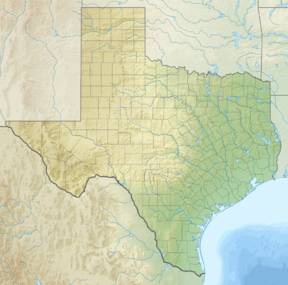| Yellow House Draw | |
|---|---|
 Yellow House Draw – a dry remnant of a wetter past Yellow House Draw – a dry remnant of a wetter past | |
  | |
| Length | 130 kilometres (81 mi) |
| Area | 9,790 square kilometres (3,780 sq mi) |
| Geography | |
| Coordinates | 33°35′34″N 101°50′02″W / 33.59278°N 101.83389°W / 33.59278; -101.83389 |
Yellow House Draw is an ephemeral watercourse about 236 km (147 mi) long, heading about 20 km (12 mi) southwest of Melrose, New Mexico, and tending generally east-southeastward across the Llano Estacado to the city of Lubbock, where it joins Blackwater Draw to form Yellow House Canyon at the head of the North Fork Double Mountain Fork Brazos River. It stretches across Roosevelt, Curry, Bailey, Cochran, Hockley, and Lubbock Counties of eastern New Mexico and West Texas, and drains an area of 9,790 km (3,780 sq mi).
Lubbock Lake Landmark
Lubbock Lake Landmark, an important archeological site and natural history preserve, is located in a meander of Yellow House Draw in the city of Lubbock, Texas. Native Americans and early settlers of the Llano Estacado used the springs in the draw until they went dry in the early 1930s due to excessive pumping of the Ogallala Aquifer. In 1936, the City of Lubbock dredged the meander in an effort to make it a usable water supply. These efforts were unsuccessful, but brought to light the archeological significance of the site. Today, very little standing water remains and no actual lake is there, but the site has become an important archeological landmark.
Canyon Lakes
Also within the city limits of Lubbock, the parks department has constructed a series of narrow lakes partly within Yellow House Draw and partly within Yellow House Canyon, collectively known as Jim Bertram Canyon Lakes System consisting of six lakes from northwest to southeast - Conquistador Lake, Llano Estacado Lake, Comancheria Lake, Vaquero Lake, Canyon Lake, and Dunbar Historical Lake. Vaquero Lake and Canyon Lake lie within Mackenzie Park and at Vaquero Lake, Blackwater Draw and Yellowhouse Draw converge. The Canyon Lakes offer scenic views and recreational opportunities, and they also function as an essential part of Lubbock's wastewater disposal system. First, the city applies treated wastewater to crops at the Lubbock Land Application Site – a 6,000-acre (24 km) site located east of the City of Lubbock. Here, 31 center-pivot sprinkler systems are used to irrigate crops with 13 million gallons of treated effluent per day. The soils and sediments of the Land Application Site act as filters as the treated wastewater percolates through the soil. To minimize contamination of the Ogallala Aquifer, groundwater is then pumped from beneath the Land Application Site to Canyon Lakes, where the water flows from one lake to the next and eventually into Yellow House Canyon, forming the North Fork Double Mountain Fork Brazos River.
See also
References
- United States Board on Geographical Names. 1964. Decisions on Geographical Names in the United States, Decision list no. 6402, United States Department of the Interior, Washington DC, p. 54.
- Seaber, P.R., Kapinos, F.P. and Knapp, G.L. 1987. Hydrological unit maps. United States Department of the Interior, U.S. Geological Survey Water-Supply Paper 2294, p. 46.
- Charles G. Davis. "Yellow House Draw". Handbook of Texas Online. Retrieved 2010-02-08.
- Eileen Johnson and Vance T. Holliday. "Lubbock Lake National Historic and State Archeological Landmark". Handbook of Texas Online. Retrieved 2010-02-08.
- Lee, G. F. and Jones, R. A. 1991. Indirect reuse of domestic wastewater for recreational lakes: evaluation of the sanitary quality of the Yellowhouse Canyon Lakes, Lubbock, Texas. In: Proc. American Water Resources Association Symposium: Water Supply and Water Reuse: 1991 and Beyond. Bethesda, MD, pp. 435-449.
- "Land Application". City of Lubbock Water Department. Retrieved 2010-02-09.
- ^ Winn, Walter Terris (August 1973). A pilot study of the Canyon Lakes Project (M.S. Thesis). Texas Tech University. hdl:2346/10133.
External links
- "An Analysis of Texas Waterways". Retrieved 2006-05-04.
- USGS Hydrologic Unit Map - State of Texas (1974)
- Public domain images of the Llano Estacado and West Texas